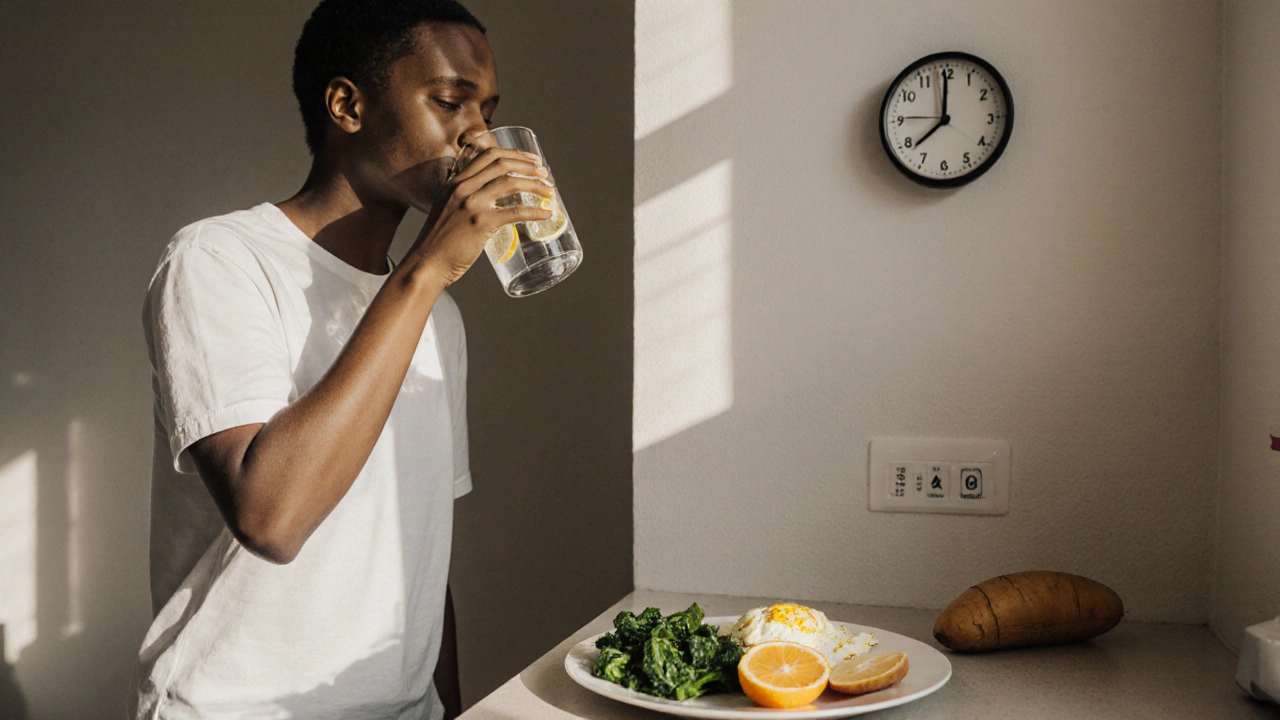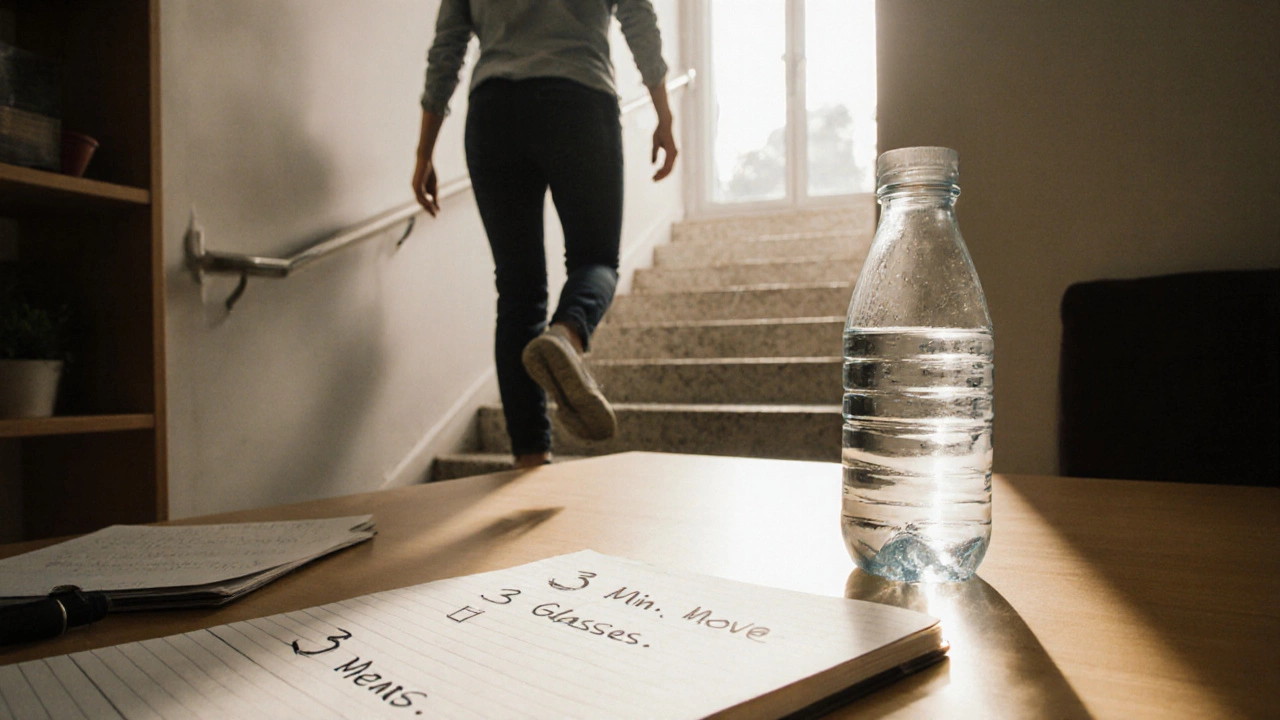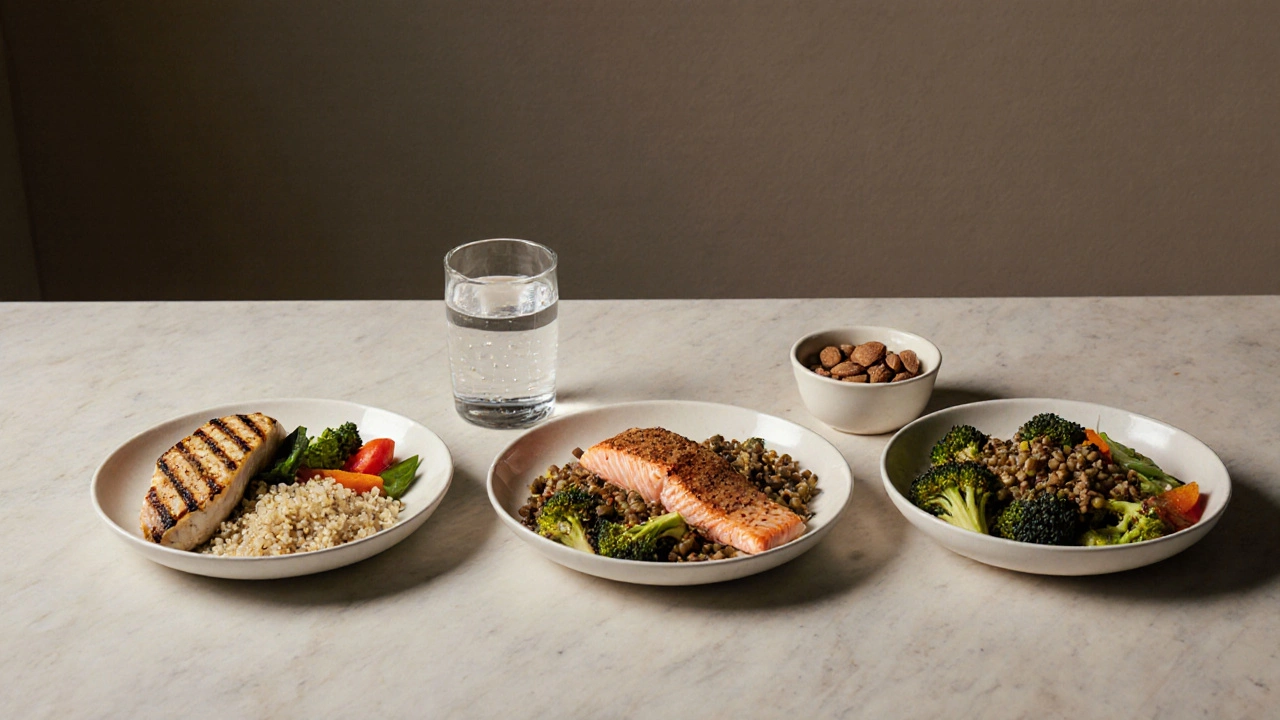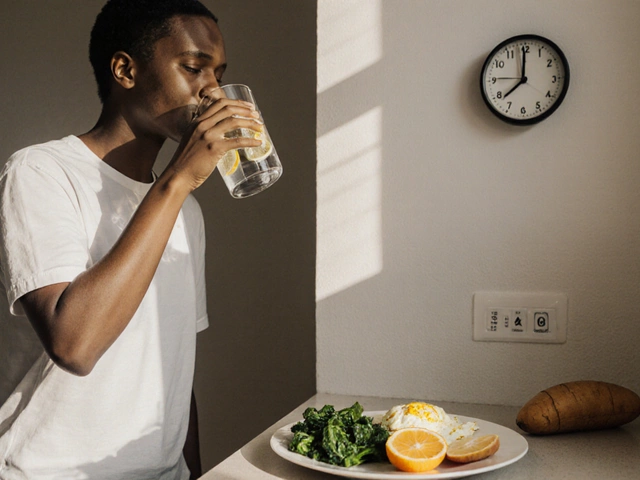- Home
- Weight Loss
- What Is the 3-3-3 Rule for Weight Loss? A Simple, Science-Backed Approach

What Is the 3-3-3 Rule for Weight Loss? A Simple, Science-Backed Approach
3-3-3 Habit Tracker
Your 30-Day Journey
Track your daily progress with the 3-3-3 rule. Log your movement, water intake, and balanced meals to see your consistency grow.
3 minutes of movement every day
3 min
3 glasses of water daily
3 glasses
3 balanced meals daily
Balanced
Daily Progress
If you’ve ever tried to lose weight, you know how overwhelming it can be. Counting calories, skipping meals, buying expensive supplements, following fad diets that vanish as fast as the pounds you lost-sound familiar? There’s a simpler way. The 3-3-3 rule for weight loss isn’t another diet. It’s a daily routine built on three basic, proven habits that work whether you’re starting from scratch or trying to break through a plateau.
What Exactly Is the 3-3-3 Rule?
The 3-3-3 rule is straightforward: three minutes of movement, three glasses of water, and three balanced meals every single day. That’s it. No calorie tracking. No extreme restrictions. No fancy apps. Just three small actions that add up to real, lasting results.
This isn’t a new idea invented by a celebrity trainer. It’s based on research from the University of Cambridge and the British Nutrition Foundation, which found that people who stuck to consistent daily habits-like hydration, regular eating, and short bursts of activity-lost more weight over six months than those on restrictive diets. The key? Consistency over intensity.
1. Three Minutes of Movement
You don’t need to run a marathon. You don’t even need a gym membership. Three minutes of movement means getting your body active in a way that raises your heart rate slightly. That could be:
- Walking briskly around your living room or office
- Doing 10 bodyweight squats
- Going up and down a flight of stairs twice
- Stretching while watching your morning news
Why does this matter? Movement sparks your metabolism. A 2023 study in the Journal of Obesity showed that people who moved for just three minutes every hour burned an extra 120 calories a day-about 840 calories a week. That’s nearly a quarter of a pound lost every week, just from moving more often.
And it’s not just about calories. Sitting for long periods slows digestion, increases insulin resistance, and makes fat storage easier. Three minutes breaks that cycle. It signals your body it’s time to burn, not store.
2. Three Glasses of Water
Most people think they’re hydrated until they feel thirsty. By then, your body is already running low. Dehydration tricks your brain into thinking you’re hungry. That’s why you snack at 3 p.m. even though you ate lunch two hours ago.
Three glasses of water-about 750 ml total-spread through the day helps you:
- Reduce unnecessary snacking
- Improve digestion
- Boost energy levels
- Support liver function (your body’s main fat-burning organ)
Drink one glass when you wake up. One before lunch. One before dinner. Don’t wait until you’re thirsty. If plain water feels boring, add a slice of lemon, cucumber, or mint. Avoid sugary drinks, even "healthy" ones like fruit juice or flavoured waters-they spike your blood sugar and undo the benefits.
A 2024 meta-analysis in Nutrition Reviews found that people who drank water before meals ate 13% fewer calories on average. That’s not magic. It’s biology.
3. Three Balanced Meals
Skipping meals doesn’t help you lose weight-it slows your metabolism and makes you crave junk later. The 3-3-3 rule says eat three meals, no more, no less. But "balanced" is the key.
A balanced meal includes:
- One palm-sized portion of protein (chicken, fish, tofu, eggs, lentils)
- One fist-sized portion of vegetables (broccoli, spinach, peppers, carrots)
- One cupped-hand portion of complex carbs (brown rice, quinoa, sweet potato, oats)
- A thumb-sized portion of healthy fat (olive oil, avocado, nuts, seeds)
That’s it. No need to weigh food. No need to count grams. Your hand is your measuring tool. It works because it scales to your body size.
For example, breakfast could be scrambled eggs with spinach and half a sweet potato. Lunch: grilled chicken, quinoa, and roasted vegetables. Dinner: baked salmon, lentils, and steamed broccoli. Snacks? Only if you’re truly hungry-and even then, go for a piece of fruit or a handful of almonds.
Studies from the Mayo Clinic show that people who eat three regular meals a day have more stable blood sugar, fewer cravings, and better long-term weight control than those who graze or skip meals.

Why This Works Better Than Diets
Diets fail because they’re temporary. The 3-3-3 rule isn’t a diet-it’s a lifestyle. You don’t "finish" it. You live it.
Here’s what happens when you stick with it:
- Week 1: You feel less bloated. Your energy steadies. You stop reaching for snacks out of habit.
- Week 3: Clothes fit better. You sleep deeper. Your cravings for sugar drop noticeably.
- Week 8: You’ve lost 4-8 pounds without feeling deprived. You’re not thinking about food all the time.
Unlike keto, intermittent fasting, or juice cleanses, the 3-3-3 rule doesn’t cut out entire food groups. You can still eat bread, pasta, or dessert-just not as the main focus of your meals.
It’s also flexible. Traveling? Skip the three-minute workout if you’re on a plane, but drink your water and eat three balanced meals. Sick? Rest, hydrate, and eat light meals. The rule adapts to your life, not the other way around.
Who Should Try the 3-3-3 Rule?
This works for almost everyone:
- Busy professionals who don’t have time for meal prep
- Parents juggling kids and work
- People over 40 struggling with slower metabolism
- Those who’ve tried diets and gained back the weight
- Anyone tired of feeling hungry all the time
It’s especially helpful for people working with weight loss clinics. Many clinics recommend the 3-3-3 rule as a foundation before adding medication or therapy. Why? Because no pill works if your daily habits are broken. The rule gives patients a clear, simple starting point.
Common Mistakes People Make
Even with a simple rule, people slip up:
- Mistake: Drinking water only when thirsty. Solution: Set phone reminders for morning, afternoon, and evening.
- Mistake: Thinking "three meals" means big portions. Solution: Use your hand, not a plate. A "balanced" meal isn’t a feast.
- Mistake: Skipping movement because "I’m too tired." Solution: Three minutes doesn’t require energy-it creates it.
- Mistake: Rewarding yourself with food after sticking to the rule. Solution: Celebrate with a walk, a new book, or a warm bath-not more food.

What to Expect in the First 30 Days
Real results come from consistency, not perfection. Here’s what most people experience:
- Days 1-7: You notice your hunger pangs are less intense. You’re not as tired after lunch.
- Days 8-14: You start sleeping better. Your skin looks clearer. You feel more in control.
- Days 15-30: You’ve lost 2-4 pounds. You no longer feel guilty about eating dessert. You’re proud you stuck with it.
Weight loss isn’t linear. Some weeks you’ll lose more. Others, you’ll plateau. That’s normal. The 3-3-3 rule keeps you moving forward even when the scale doesn’t budge.
How to Stick With It
Here’s how to make the 3-3-3 rule stick:
- Write it on your fridge: "3 Min. Move. 3 Glasses. 3 Meals."
- Use a habit tracker app (like Habitica or Streaks) to mark off each day.
- Pair it with something you already do: Drink water while brushing your teeth. Move after your morning coffee.
- Find one person to check in with weekly. Accountability works-even if it’s just a text saying, "Did your 3-3-3 today?"
You don’t need motivation. You just need repetition. After 30 days, it becomes automatic. Your body starts expecting it. Your brain starts rewarding it.
Final Thought: It’s Not About Losing Weight. It’s About Feeling Better.
The 3-3-3 rule isn’t designed to make you skinny. It’s designed to make you feel strong, steady, and in charge of your health. The weight loss? That’s a side effect.
If you’ve tried everything and still feel stuck, start here. Three minutes. Three glasses. Three meals. Do it for 30 days. Then decide if it’s working for you. Chances are, you’ll be surprised by how much better you feel-even before the scale changes.
Does the 3-3-3 rule work for people with medical conditions like diabetes or thyroid issues?
Yes, the 3-3-3 rule is safe and often recommended for people with diabetes, hypothyroidism, or PCOS. Regular meals help stabilize blood sugar. Hydration supports kidney function. Movement improves insulin sensitivity. Always talk to your doctor before making changes, but this routine doesn’t conflict with most medications or treatments. Many weight loss clinics use it as a baseline for patients with chronic conditions.
Can I do the 3-3-3 rule if I’m vegetarian or vegan?
Absolutely. Protein can come from tofu, tempeh, lentils, chickpeas, edamame, or seitan. Complex carbs include oats, quinoa, buckwheat, and whole grain bread. Vegetables and healthy fats like avocado, nuts, and olive oil are already plant-based. The rule adapts to any diet-it’s about structure, not food choices.
What if I’m not hungry for three meals a day?
If you’re not hungry, eat smaller portions-but don’t skip meals. Your body needs consistent fuel to keep your metabolism active. Try a light meal: a boiled egg with avocado toast, or a smoothie with protein powder and spinach. Skipping meals slows fat burning and can trigger overeating later.
How much weight can I expect to lose with the 3-3-3 rule?
Most people lose 1-2 pounds per week safely. That’s 4-8 pounds in a month. It’s slower than crash diets, but it sticks. People who lose weight too fast often regain it. The 3-3-3 rule helps you lose fat, not muscle or water, so the results last.
Do I need to join a weight loss clinic to follow the 3-3-3 rule?
No. The rule works on its own. But if you’re struggling with emotional eating, past diet failures, or medical barriers, a weight loss clinic can help you stay on track with coaching, monitoring, and support. The rule is the foundation-clinics build on top of it.
Next Steps: Start Today
Don’t wait for Monday. Don’t wait for a new month. Start now. Right after you finish reading this:
- Drink a glass of water.
- Walk for three minutes-around your house, up and down stairs, or outside.
- Plan your next meal with protein, vegetables, and a complex carb.
That’s your first 3-3-3. Do it again tomorrow. And the next day. In 30 days, you won’t just be lighter-you’ll feel like a different person.

Arnav Singh
I am a health expert with a focus on medicine-related topics in India. My work involves researching and writing articles that aim to inform and educate readers about health and wellness practices. I enjoy exploring the intersections of traditional and modern medicine and how they impact healthcare in the Indian context. Writing for various health magazines and platforms allows me to share my insights with a wider audience.
About
Medical Resource Center India is a comprehensive online platform dedicated to providing reliable health information and medical resources in India. Explore a wide range of articles, tips, and advice on medicine, healthcare services, and wellness. Stay informed about the latest developments in Indian medicine and access valuable insights into maintaining a healthy lifestyle. Discover expert guidance and health solutions tailored for every Indian citizen. Your go-to destination for authoritative medical knowledge in India.








